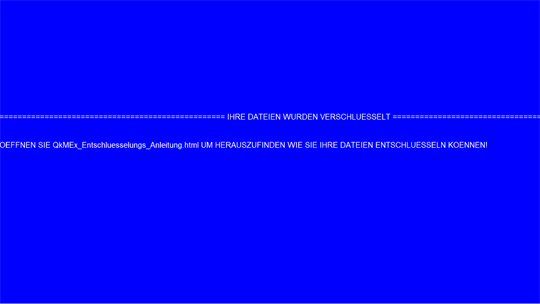Ransom.Win32.ENTSCRYPT.B
Ransom:Win32/Gerwip (Microsoft); Trojan-Ransom.e (McAfee); Trojan.Win32.Yakes.ywph (Kaspersky); Troj/Ransom-FOO (Sophos); Trojan.Win32.Generic!BT (Sunbelt)
Windows


Threat Type: Ransomware
Destructiveness: No
Encrypted: No
In the wild: Yes
OVERVIEW
This Ransomware arrives on a system as a file dropped by other malware or as a file downloaded unknowingly by users when visiting malicious sites.
It drops files as ransom note.
TECHNICAL DETAILS
Arrival Details
This Ransomware arrives on a system as a file dropped by other malware or as a file downloaded unknowingly by users when visiting malicious sites.
Installation
This Ransomware adds the following processes:
- {Malware Directory}\{Malware File Name}.exe
- iexplore %Desktop%\{5 random characters}_Entschluesselungs_Anleitung.html → opens ransom note in Internet Explorer
- vssadmin delete shadows /all /quiet → deletes shadow copies
- bcdedit /set {default} recoveryenabled no → disables automatic repair
- bcdedit /set {default} bootstatuspolicy ignoreallfailures → disables Windows error recovery
(Note: %Desktop% is the current user's desktop, which is usually C:\Documents and Settings\{User Name}\Desktop on Windows 2000(32-bit), XP, and Server 2003(32-bit), or C:\Users\{user name}\Desktop on Windows Vista, 7, 8, 8.1, 2008(64-bit), 2012(64-bit) and 10(64-bit).)
Other System Modifications
This Ransomware sets the system's desktop wallpaper to the following image:
Dropping Routine
This Ransomware drops the following files:
- %User Temp%\sasi.bmp → used as wallpaper
(Note: %User Temp% is the current user's Temp folder, which is usually C:\Documents and Settings\{user name}\Local Settings\Temp on Windows 2000(32-bit), XP, and Server 2003(32-bit), or C:\Users\{user name}\AppData\Local\Temp on Windows Vista, 7, 8, 8.1, 2008(64-bit), 2012(64-bit) and 10(64-bit).)
Other Details
This Ransomware does the following:
- It avoids wiping the content of files with the following extensions:
- .386
- .adv
- .ADV
- .ani
- .ANI
- .bat
- .BAT
- .bin
- .BIN
- .cab
- .CAB
- .cmd
- .CMD
- .com
- .COM
- .cpl
- .CPL
- .cur
- .CUR
- .deskthemepack
- .DESKTHEMEPACK
- .diagcab
- .DIAGCAB
- .diagcfg
- .DIAGCFG
- .diagpkg
- .DIAGPKG
- .dll
- .DLL
- .drv
- .DRV
- .exe
- .EXE
- .hlp
- .HLP
- .icl
- .ICL
- .icns
- .ICNS
- .ico
- .ICO
- .ics
- .ICS
- .idx
- .IDX
- .ldf
- .lnk
- .LNK
- .mod
- .MOD
- .mpa
- .MPA
- .msc
- .MSC
- .msp
- .MSP
- .msstyles
- .MSSTYLES
- .msu
- .MSU
- .nls
- .NLS
- .nomedia
- .NOMEDIA
- .ocx
- .OCX
- .prf
- .PRF
- .psl
- .PSL
- .rom
- .ROM
- .rtp
- .RTP
- .scr
- .SCR
- .shs
- .SHS
- .spl
- .SPL
- .sys
- .SYS
- .theme
- .THEME
- .themepack
- .THEMEPACK
- .WPX
- .lock
- .LOCK
- .hta
- .HTA
- .msi
- .MSI
- It avoids wiping the content of files with the following file names:
- autorun.inf
- boot.ini
- bootfont.bin
- bootsect.bak
- desktop.ini
- iconcache.db
- ntldr
- ntuser.dat
- ntuser.dat.log
- ntuser.ini
- bootmgr
- bootnxt
- thumbs.db
- It avoids wiping the content of files found in the following folders:
- windows
- recycle.bin
- mozilla
- boot
- application data
- appdata
- program files
- program files (x86)
- programme
- programme (x86)
- programdata
- perflogs
- intel
- msocache
- system volume information
- It appends the following extension to the file name of the files with wiped content:
- .{5 random characters}
Ransomware Routine
This Ransomware drops the following file(s) as ransom note:
- {5 random characters}_Entschluesselungs_Anleitung.html

SOLUTION
Step 1
Trend Micro products with the XGen technology detect this malware as
- Troj.Win32.TRX.XXPE50FFF031
Step 2
Before doing any scans, Windows 7, Windows 8, Windows 8.1, and Windows 10 users must disable System Restore to allow full scanning of their computers.
Step 3
Note that not all files, folders, and registry keys and entries are installed on your computer during this malware's/spyware's/grayware's execution. This may be due to incomplete installation or other operating system conditions. If you do not find the same files/folders/registry information, please proceed to the next step.
Step 4
Identify and terminate files detected as Ransom.Win32.ENTSCRYPT.B
- Windows Task Manager may not display all running processes. In this case, please use a third-party process viewer, preferably Process Explorer, to terminate the malware/grayware/spyware file. You may download the said tool here.
- If the detected file is displayed in either Windows Task Manager or Process Explorer but you cannot delete it, restart your computer in safe mode. To do this, refer to this link for the complete steps.
- If the detected file is not displayed in either Windows Task Manager or Process Explorer, continue doing the next steps.
Step 5
Search and delete these files
- %User Temp%\sasi.bmp
- {Encrypted Directory}\{5 random characters}_Entschluesselungs_Anleitung.html
Step 6
Scan your computer with your Trend Micro product to delete files detected as Ransom.Win32.ENTSCRYPT.B. If the detected files have already been cleaned, deleted, or quarantined by your Trend Micro product, no further step is required. You may opt to simply delete the quarantined files. Please check the following Trend Micro Support pages for more information:
Step 7
Reset your Desktop properties
Step 8
Restore encrypted files from backup.
NOTES:
Enabling Volume Shadow Service
- Run the command prompt (cmd.exe) as administrator.
- Enable volume shadow service using the following command:
net start vss
- Run the command prompt (cmd.exe) as administrator.
- Enable Windows error recovery screen on startup using the following command:
bcdedit /set {default} bootstatuspolicy displayallfailures
- Run the command prompt (cmd.exe) as administrator.
- Enable startup repair using the following command:
bcedit /set {default} recoveryenabled Yes
Did this description help? Tell us how we did.


